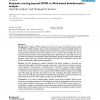Free Online Productivity Tools
i2Speak
i2Symbol
i2OCR
iTex2Img
iWeb2Print
iWeb2Shot
i2Type
iPdf2Split
iPdf2Merge
i2Bopomofo
i2Arabic
i2Style
i2Image
i2PDF
iLatex2Rtf
Sci2ools
BMCBI
2007
2007
Seahawk: moving beyond HTML in Web-based bioinformatics analysis
Background: Traditional HTML interfaces for input to and output from Bioinformatics analysis on the Web are highly variable in style, content and data formats. Combining multiple analyses can therfore be an onerous task for biologists. Semantic Web Services allow automated discovery of conceptual links between remote data analysis servers. A shared data ontology and service discovery/execution framework is particularly attractive in Bioinformatics, where data and services are often both disparate and distributed. Instead of biologists copying, pasting and reformatting data between various Web sites, Semantic Web Service protocols such as MOBY-S hold out the promise of seamlessly integrating multi-step analysis. Results: We have developed a program (Seahawk) that allows biologists to intuitively and seamlessly chain together Web Services using a data-centric, rather than the customary servicecentric approach. The approach is illustrated with a ferredoxin mutation analysis. Seahawk conc...
| Added | 08 Dec 2010 |
| Updated | 08 Dec 2010 |
| Type | Journal |
| Year | 2007 |
| Where | BMCBI |
| Authors | Paul M. K. Gordon, Christoph W. Sensen |
Comments (0)

